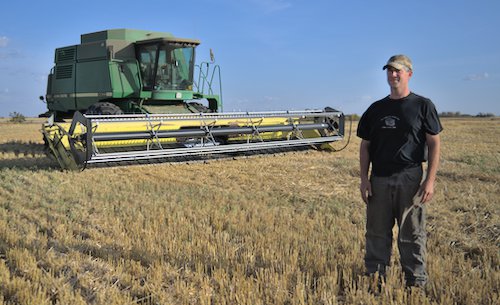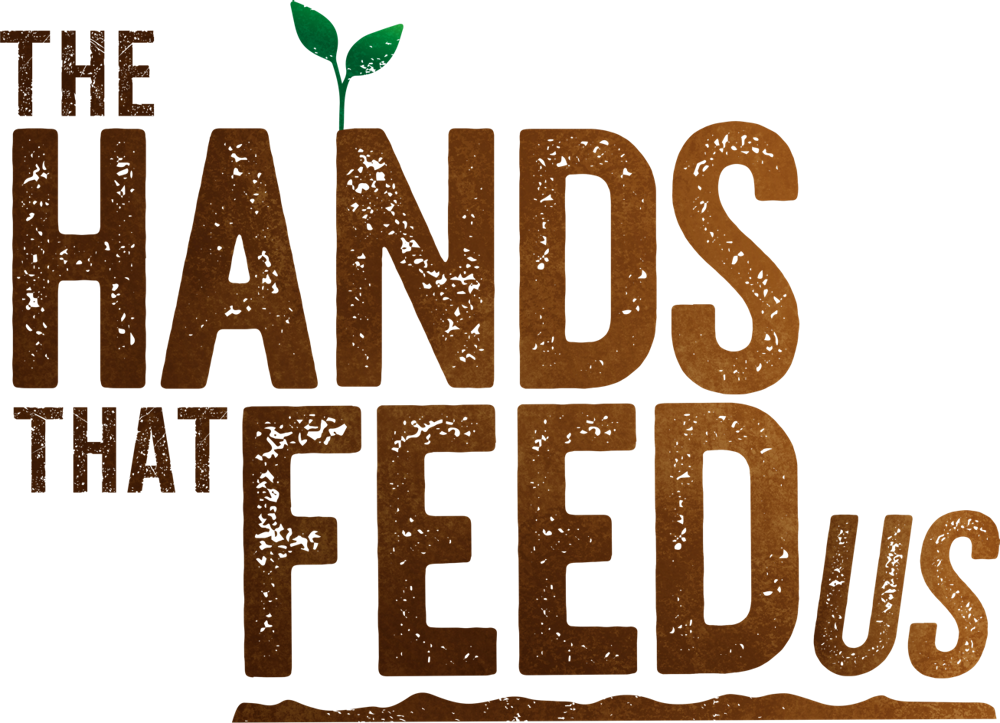Prairie harvest is a race against winter
Five weeks ago, I interrupted my time at The Farm with The Good Food to head east to join Nathan Eshpeter on his farm, deep in grain country. Harvest was starting, and I didn’t want to miss it. More than any other farm I’ve been to, the Eshpeter farm is at the mercy of the weather and the seasons. 2020 has been an exceptionally wet year on the prairies. When I arrived in late August, it was raining regularly every 3-4 days — not just a prairie sprinkle, but a full-sky downpour. Signs of water were everywhere, and the fields were pockmarked with giant mud puddles where crops had drowned if they had been seeded at all. Nathan missed the window for seeding his flax in the spring because the fields were too wet to drive on. Instead, he seeded barley for animal feed — a much less lucrative crop.
Because of the water (and unseasonably cool temperatures), the crops were taking a long time to mature, but harvest was beginning anyway. The memory of last year’s Harvest from Hell hung heavy in the air even if nobody mentioned it. If Nathan waited for the perfect maturity and moisture levels to arrive naturally, he might miss his chance to get the crop off the field before winter, so harvest was going to happen anyway, ready or not. I was there to capture it on camera.
Nathan farms “about as much land as it’s possible for one farmer to take care of” — in his case about 2,200 acres. That’s two orders of magnitude bigger than the 50 acres at Klippers, and Klippers employed a dozen Jamaican workers. So what’s the difference? Machinery. At Amara Farm, having fields that were too wet to drive on would barely have been noticed. For Nathan, it was a major crisis because literally everything he does on the farm, from seeding to combining, involves heavy machinery that drives on the fields. That machinery is the difference between Amara farming 2.5 acres, and Nathan farming 2,200.
It’s difficult to express how much land is encompassed by 2,200 acres. Saying it’s just shy of four square miles isn’t much help visualizing it. But if you grew up in Vancouver like I did, here’s a touchpoint. It just so happens that the Downtown Peninsula, including Stanley Park, is about 2,200 acres. So picture a farm the size of downtown Vancouver … and one person takes care of it all. On top of that, the grain from those 2,200 acres doesn’t even support his family — until he was laid off this spring, he had a full-time job as a mechanical engineer.
Bear with me through one more round of hypothetical calculations. If it was all planted in wheat, Nathan’s 2,200 acres would generate about 3,300 tonnes of wheat in a decent year. Those 3,300 tonnes contain about 10 billion calories, which means if people were eating nothing but wheat (don’t try this at home), Nathan on his own could feed about 14,000 people. Or, to bring Vancouver back into the picture, Nathan working on his own could feed just under a quarter of downtown residents. But he wouldn’t earn a good enough wage to quit his day job…
What does it take to get a prairie farm started?

Like most prairie farmers, Nathan grew up on the farm. Over the last couple decades, he’s slowly taken over the family farm from his father. But even with family support, it’s no cakewalk to get started.
To begin with, he needed to buy the land. Land around Daysland, Alberta is going for roughly $5,000 / acre. Compared to B.C., that sounds cheap! Until you realize how big a “normal size” farm is. $5,000 × 2,200 acres = $11 million. Oh. Luckily, it’s family, so let’s say he got it for 50% of market price. That’s still $5.5 million. Where does a young man who’s just getting established get money like that? Gee, Dad, do you think I could borrow $5.5 million?
As I understand it, that’s a simplified version of how Nathan took over. In reality, Nathan has a brother, his father needed something to live on in his retirement, and that doesn’t even consider the cost of all the farm equipment (new combine harvesters go for more than $1 million). Hopefully, Nathan got a deal on the equipment too… Long story short, it cost Nathan millions just to get to the point where he could plant his first crop.
Nathan’s secret advantage is his training as a mechanical engineer. Wait a decade or two, and that million dollar combine can be had for $25,000. A bargain, even when you factor in the additional $25,000 of repairs and maintenance that it takes to make it harvest-worthy — as long as you’re willing to do the work yourself, as Nathan is. In fact, fixing, tinkering with, and maintaining his many, many pieces of farm machinery seemed to occupy the majority of Nathan’s time while I was around. When every job on the farm requires a machine, taking care of the machines becomes just as much a part being a farmer as knowing when to seed or how to avoid fusarium blight.
When I arrived at the farm, Nathan was just gearing up for harvest. That meant inspecting and maintaining two combine harvesters, a swather, two tractors and three grain trucks. Harvest is time-sensitive, so he needed to make sure the machinery wasn’t going to break down at a critical moment. Despite the week he spent getting his equipment ready, the combine harvester broke down no less than three times in the middle of harvest. While I was there, I saw him repair the header canvas (twice), replace a hydraulic hose that had split open, and repair a cooling hose in the engine. That’s not a slight against his abilities as a mechanic — this is what is expected during harvest. When I interviewed Nathan about what happens on a “typical” day during harvest, his answer was that the first thing he does in a day is “fix whatever broke on the combine yesterday”. As he said, you expect breakdowns, you plan for them, and you build some downtime into your schedule.
How feudal are our farmers?
For almost as long as I’ve been thinking about this project, I’ve had a fear in the back of my head. That fear is: What if we revert to feudalism. Don’t laugh. Also, probably don’t take it literally — feudalism was a non-market society based primarily around military obligations. It was a bit of a protection racket: “If you pledge allegiance to me and agree to fight in my army, I’ll make sure the guy next door doesn’t come and burn your fields with his army.” If the wikipedia definition (or lack thereof) is anything to judge by, the precise nature of feudalism is subject to contentious academic debate which I have no wish to contribute to.
We probably aren’t going back to a world of lords, knights, and vassals any time soon. But, I think there is something to the underlying fear, which is that farmers will lose control of their land and become beholden to large, absent land-owners. That scenario seems much more likely — likely enough for me to explore my fear in a blog post: How Feudal are our Farmers?
Combine harvesters and baby’s first farm machine
In honour of the many, many pieces of machinery at Nathan’s farm, it seems that most of what I talked about on YouTube was … machinery! So, if you want to see some of it in action, you can catch up on some of my weekly YouTube updates. Don’t miss “unloading on the go” … where a combine empies its load of wheat into a grain truck while it continues to harvest on the field.
If machinery isn’t your thing, Nathan proved deeply insightful on the nature of wealth and I shared the first (and so far only) clip of an interview from the film in Wealth is for the Birds.
Here’s some of the highlights:
- Trucks, Combines, and Mobile Homes (Alberta Stereotypes): My first impressions of being on a farm of this size.
- When Sound Equipment goes through a Combine Harvester, in which I talk about a piece of equipment that I … lost.
- Baby’s First Farm Machine, where I finally managed to operate some machinery of my own!
What’s next?
For now, I’m back at The Farm with The Good Food waiting for the cows to come home. I realize I haven’t said much about my time here yet, but that’s because I’m still not done filming! Next update…
- My primary objective at The Farm with The Good Food is to film a cattle auction. This should happen next week…
- While I’m waiting, I’ve been filming (and helping build) a calving shed so that the calves don’t freeze to death at 30 below when they are born in February. As calving sheds go, I’m told that this one is a particularly luxurious model, with two stalls, a fine, vaulted roof, and, thanks to yours truly, several hundred screws in the roof to make sure the wind doesn’t blow it away.
- I’m heading east to Saskatchewan to interview the best researcher about farm incomes I’ve found: Darrin Qualman. While I’m there I’ll interview to several other experts.
- After that, I’m headed to the last farm on my journey: A dairy farm. The only trouble is, I don’t know where that farm is just yet. It could be Nova Scotia, it could be here in Alberta, or maybe I’ll come back to B.C.
How can I help?
- Forward this newsletter to any farmers you know. I’m still looking for a dairy farmer to be part of the film!
- Share one of my YouTube updates on social media. Vegetarian on a Beef Farm is a good one to start with.
- Read How Feudal are our Farmers?, send it to a friend, and then have a conversation about it. Then tell me what you thought! Criticism is especially welcome!
